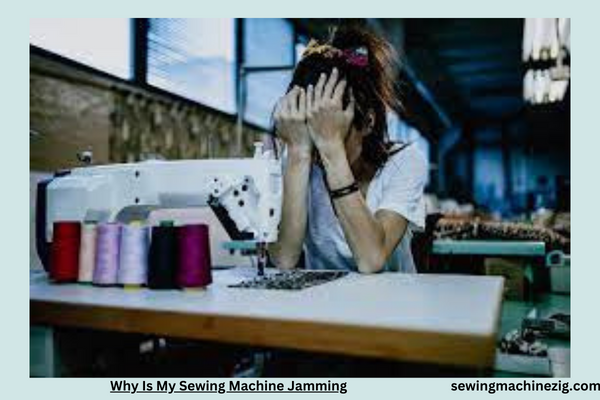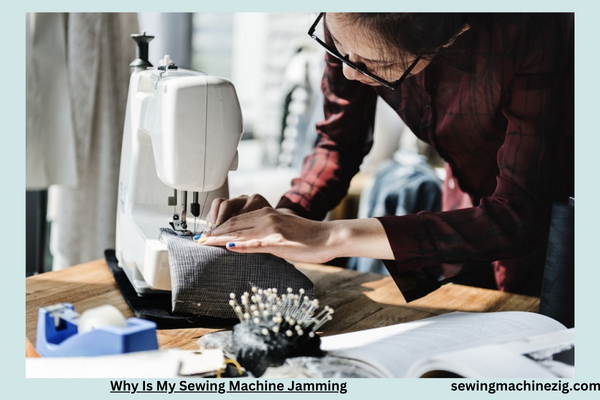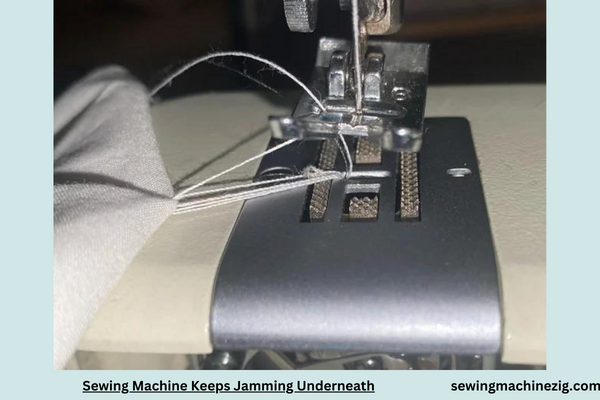
Experiencing a jammed sewing machine can be a frustrating obstacle in the midst of a creative endeavor. Understanding the reasons behind this common issue is key to resolving it effectively. If you’ve found yourself pondering, “Why is my sewing machine jamming?” fear not. In this insightful guide, we’ll unravel the mysteries behind sewing machine jams, exploring common causes such as incorrect threading, bobbin issues, and needle-related issues.
By delving into the intricacies of sewing machine mechanics, you’ll gain the knowledge needed to troubleshoot and prevent jams, ensuring a smooth and uninterrupted sewing experience.
Why Is My Sewing Machine Jamming Detailed Answer

Experiencing frequent jams in your sewing machine can be a frustrating roadblock to your creative endeavors. However, fear not! This step-by-step guide “Why is my sewing machine jamming” is designed to unravel the mysteries behind why your sewing machine is jamming and provide practical solutions to get you back on track.
Step 1: Diagnose the Jam
Understanding the nature of the jam is the first step in finding a solution. Is the needle stuck in the fabric? Are there tangled threads underneath? Pinpointing the issue will guide you toward an effective resolution.
Step 2: Quality Thread Matters
The thread you use can significantly impact your sewing machine’s performance. Opt for high-quality thread suitable for your fabric and machine. Old or low-quality thread is more prone to breakage and can lead to frustrating jams.
Step 3: Needle Inspection
A bent or worn-out needle is a common culprit for sewing machine jams. Regularly check and replace needles, ensuring they are the correct type and size for your fabric. A mismatched needle can cause unnecessary friction, leading to jams.
Step 4: Tackle Thread Tension
Incorrect thread tension is a major contributor to jams. Check both the upper and lower thread tensions, ensuring they are correctly set. Consult your sewing machine manual for guidance on adjusting tension settings for optimal performance.
Step 5: Clear Out Lint and Debris
Lint buildup in the bobbin area and other parts of your sewing machine can wreak havoc. Regularly clean your machine, focusing on the bobbin case, feed dogs, and needle plate. A small brush can help you remove accumulated lint and debris.
Step 6: Re-thread with Precision
Proper threading is paramount to prevent jams. Unthread your machine completely and re-thread it carefully, following the threading path outlined in your manual. Ensure the thread passes through all necessary guides and tension discs.
Step 7: Bobbin Matters
A poorly wound or incorrectly inserted bobbin can lead to jams. Wind your bobbin evenly and insert it correctly into the bobbin case. Check for any tangles or uneven winding that might contribute to the issue.
Step 8: Needle and Fabric Compatibility
Ensure your needle size and type align with the fabric you’re working with. Using the wrong needle for the job can lead to jams, especially when dealing with thick or delicate fabrics.
Step 9: Adjust Stitching Speed
Sewing at breakneck speed may be tempting, but it can contribute to jams, especially with intricate stitches or challenging fabrics. Slow down your stitching speed to allow the machine to handle the fabric more effectively.
Step 10: Examine Feed Dogs
Ensure your feed dogs are moving smoothly. Stuck or malfunctioning feed dogs can cause fabric to bunch up, resulting in jams. Refer to your machine’s manual for troubleshooting tips related to feed dog issues.
Step 11: Inspect for Mechanical Problems
If all else fails, a deeper inspection is necessary. Loose screws, misalignments, or damaged parts could be contributing to the jams. If you’re not comfortable addressing mechanical issues, seek professional assistance.
Step 12: Refer to Your Manual
Your sewing machine manual is a treasure trove of information. Turn to the troubleshooting section for guidance on resolving jams and any other issues specific to your machine model.
By following these comprehensive steps, you’ll be equipped to troubleshoot and resolve the frustrating issue of your sewing machine jamming. Consistent maintenance practices and proper sewing techniques will contribute to the overall smooth operation of your machine.
Remember, your sewing machine is a valuable tool—taking the time to understand and address issues will ensure it serves you well for countless creative projects.
Sewing Machine Keeps Jamming Underneath

Dealing with a sewing machine that consistently jams underneath can be a frustrating experience for any sewist. However, fear not – this comprehensive step-by-step guide is here to help you troubleshoot and resolve the issue, ensuring smooth and stress-free sewing sessions. Let’s dive into the process of identifying and fixing why your sewing machine keeps jamming underneath.
Step 1: Stop Sewing Immediately
When you notice your sewing machine jamming underneath, the first and most crucial step is to stop sewing immediately. Continuing to sew while the machine is jammed can lead to further issues and potential damage.
Step 2: Remove the Fabric and Cut Threads
Carefully lift the presser foot and remove the fabric from the sewing machine. Examine the fabric and cut any tangled threads using a pair of sharp scissors. Ensure that no fabric or thread remnants are caught in the feed dogs or needle area.
Step 3: Check the Needle for Damage
Examine the needle closely for any signs of damage, such as bends or burrs. A damaged needle can cause the sewing machine to jam. If you find any issues, replace the needle with a new one. Make sure to use the correct needle type and size for your fabric.
Step 4: Clean the Bobbin Area
Access the bobbin area and remove the bobbin case. Inspect the bobbin for any tangled threads or lint. Use a small brush or a can of compressed air to clean out any debris in the bobbin area. Ensure that the bobbin is inserted correctly, following the machine’s manual.
Step 5: Re-Thread the Machine
Proper threading is crucial for preventing jams. Unthread the machine completely, both the upper thread and the bobbin thread. Refer to your
machine’s manual to ensure you are threading it correctly. Pay special attention to the threading path, making sure the thread passes through all the necessary guides and tension discs.
Step 6: Check Upper Thread Tension
Improper tension can lead to thread jams. Ensure that the upper thread is correctly threaded through the tension discs and that there is appropriate tension. Consult your sewing machine manual to understand how to adjust the tension settings. You may need to experiment with different tension levels based on your fabric and thread.
Step 7: Test Sew on Scrap Fabric
Before resuming your actual project, perform a test stitch on a scrap piece of fabric. This allows you to observe the machine’s performance and make any necessary adjustments. Ensure that the stitches are forming correctly and that there are no signs of jamming.
Step 8: Inspect the Bobbin Thread
Check the bobbin thread for any irregularities. Ensure that it is wound evenly and inserted correctly into the bobbin case. If the bobbin thread is too loose or too tight, it can contribute to jams. Adjust the bobbin tension according to your machine’s manual.
Step 9: Examine the Feed Dogs
The feed dogs play a crucial role in moving the fabric through the machine. Inspect the feed dogs for any trapped threads or debris. Clean the feed dogs using a brush to ensure they move freely and smoothly.
Step 10: Sew Slowly and Mindfully
As you resume your sewing project, make a conscious effort to sew slowly and observe the machine’s performance. Sewing too quickly can sometimes lead to jams, especially if there are issues with tension or threading. Taking it slow allows you to catch any potential problems before they escalate.
Step 11: Lubricate Moving Parts
Refer to your sewing machine manual for guidance on lubricating moving parts. Lack of lubrication can contribute to jams and affect the overall performance of the machine. Follow the manual’s recommendations on the type of oil to use and the specific points that require lubrication.
Step 12: Consult Professional Assistance
If, after following these steps, your sewing machine continues to jam underneath, it may be time to seek professional assistance. Contact the manufacturer’s customer support or take your machine to a certified technician for a thorough inspection and potential repairs.
Step 13: Regular Maintenance Practices
To prevent future jams, incorporate regular maintenance practices into your sewing routine. Clean the machine after each project, change needles regularly, and follow the manufacturer’s recommendations for maintenance intervals. A well-maintained machine is less likely to experience issues.
By following this comprehensive step-by-step guide, you can troubleshoot and resolve the issue of your sewing machine jamming underneath. Remember to approach each step methodically and refer to your machine’s manual for specific instructions. With patience and attention to detail, you’ll soon be back to enjoying uninterrupted and smooth sewing sessions.
Conclusion
In conclusion, understanding why a sewing machine is jamming is pivotal to maintaining a smooth stitching experience. From improper threading and needle issues to tension imbalances and bobbin malfunctions, identifying the root cause empowers users to troubleshoot effectively. Regular cleaning, adherence to proper threading techniques, and using the right needles contribute to preventing jams.
A well-maintained sewing machine ensures consistent performance, allowing enthusiasts to focus on their creative projects without the frustration of unexpected interruptions.
FAQS
Q1: Why is my sewing machine jamming frequently?
A1: Sewing machine jams can be caused by various factors. Common issues include incorrect threading, using the wrong needle or thread, and bobbin-related problems. Identifying the specific cause is crucial to resolving the jamming issue.
Q2: How can I troubleshoot a jamming sewing machine?
A2: Begin by rethreading the machine, ensuring the thread follows the correct path. Check for needle compatibility with the fabric, use quality thread, and confirm the bobbin is correctly inserted. Cleaning the machine and checking for lint buildup also aids in preventing jams.
Q3: Can using the wrong needle cause sewing machine jams?
A3: Yes, using an inappropriate needle for the fabric type or sewing task can lead to jams. Ensure the needle is suitable for the fabric thickness, and replace it regularly to prevent dullness or damage that may contribute to jams. “Why is my sewing machine jamming“
Q4: Is there a connection between improper tension settings and sewing machine jams?
A4: Absolutely. Incorrect tension settings, either too tight or too loose, can result in sewing machine jams. Adjust the upper and lower thread tensions according to the machine’s manual for optimal stitching. “Why is my sewing machine jamming“
Q5: Can a malfunctioning bobbin cause sewing machine jams?
A5: Yes, a malfunctioning bobbin, such as incorrect threading or issues with the bobbin case, can lead to jams. Ensure the bobbin is correctly wound, inserted, and the thread properly threaded through the bobbin case. “Why is my sewing machine jamming“
Q6: Should I clean my sewing machine regularly to prevent jams?
A6: Yes, regular cleaning is crucial. Lint and debris can accumulate in the bobbin area and other parts, causing jams. Follow the manufacturer’s guidelines for cleaning and maintenance to keep your sewing machine running smoothly. “Why is my sewing machine jamming“



